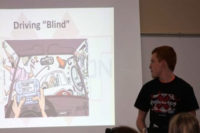OSHA’s Michaels targets texting while driving on the job
 Noting that millions of workers’ jobs require them to drive, OSHA chief Dr. David Michaels is urging employers to enact policies that prohibit texting – a particularly dangerous part of the distracted driving “epidemic” that accounts for approximately 16 percent of traffic fatalities.
Noting that millions of workers’ jobs require them to drive, OSHA chief Dr. David Michaels is urging employers to enact policies that prohibit texting – a particularly dangerous part of the distracted driving “epidemic” that accounts for approximately 16 percent of traffic fatalities.
In “Work in Progress,” the U.S. Department of Labor blog, Michaels discussed an initiative launched a year ago by OSHA and the Department of Transportation to combat distracted driving.
“You might ask: Why OSHA? Why distracted driving?,” writes Michaels. “The answer: Motor vehicle crashes are the leading cause of worker fatalities year after year. There is no doubt that the grim consequences of distracted driving we observe in the general population are seen in work-related crashes as well.”
He urged employers to neither require nor condone texting while driving, who are distracted by incoming texts or emails from supervisors or clients are being exposed to a serious hazard.
“OSHA is first targeting its efforts on texting because it encompasses all three types of dangerous distraction; it takes your cognitive focus, your eyes and your hands away from the work of driving,” said Michaels. “A Federal Motor Carrier Safety Administration study finds that drivers’ eyes are off the road for 4.6 out of every 6 seconds while texting. At 55 mph, that’s like driving the length of a football field while wearing a blindfold.”
Michaels pointed to more than 1,600 companies surveyed by the DOT who have already put prohibiting distracted driving among their employees. Thirty-four states and the District of Columbia have banned texting on the roadways, and President Obama issued an executive order prohibiting federal employees from texting while driving on official business.
“We are asking employers to declare their vehicles “text-free zones” and to back up that declaration with worker education and with policies that explicitly ban texting while driving and establish work procedures and rules that do not make it necessary for workers to text while driving in order to carry out their duties,” he said. “Employers should set up clear procedures, times, and places for drivers’ safe use of texting and other technologies for communicating with managers, customers, and others, and incorporate safe communications practices into worker orientation and training.”
He added that companies who require texting while driving will be subject to an OSHA investigation and could be issued citations and penalties.
“When you are driving on the job, your job is to drive, not to text or talk on the phone. Driving itself is dangerous work. Any practice that increases the risks of that work is unacceptable.”
Looking for a reprint of this article?
From high-res PDFs to custom plaques, order your copy today!







